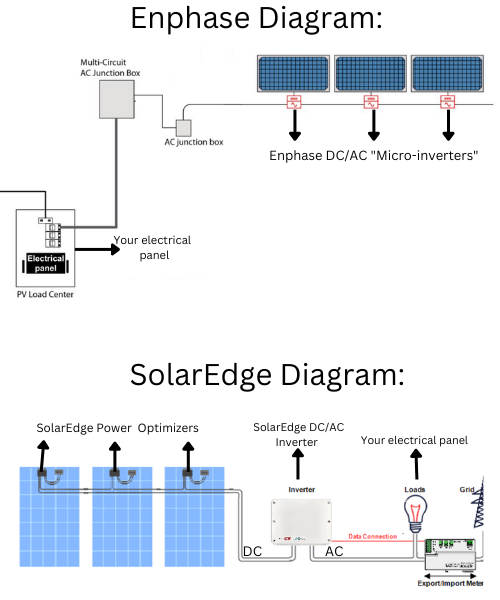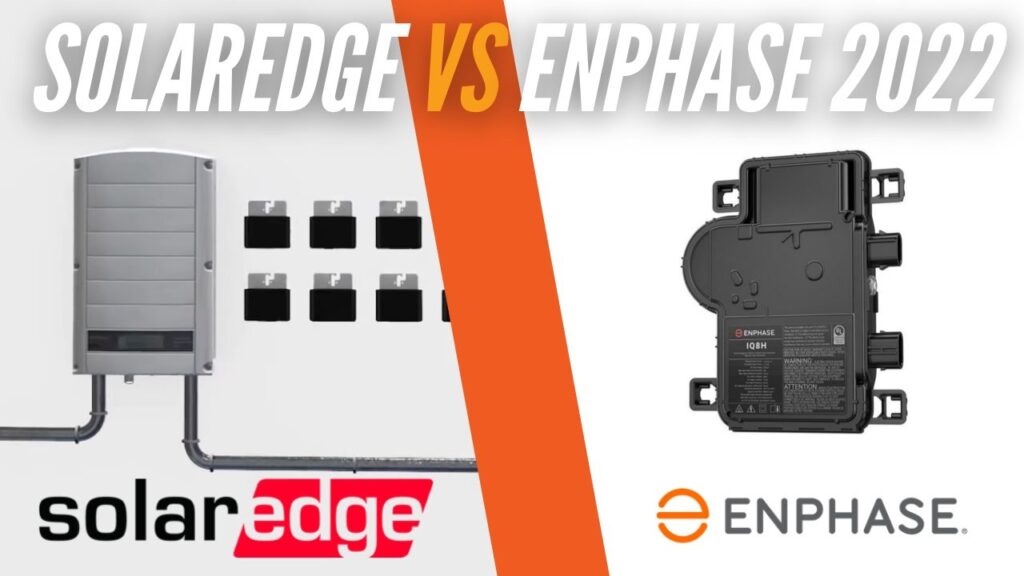13 important considerations: SolarEdge VS Enphase in 2024
SolarEdge VS Enphase
In 2022, one may argue that the most important component of a solar energy system is not the actual panels but rather the inverter. SolarEdge and Enphase are by far the best inverters available in the market. Both brands are relatively reliable and unlike the typical string inverter, SolarEdge and Enphase protect the array from having one shaded panel affecting the energy production of the entire array.
Additionally, both offer a thorough online-monitoring platform where one can track live-energy-production at a panel by panel level.
But, which one is better?
Table of Content:
- Main difference between SolarEdge VS Enphase
- SolarEdge VS Enphase “peripheral” or “extra” devices
- SolarEdge vs Enphase simple diagram
- Cost of SolarEdge vs Enphase
- Which one is more reliable
- Inverters limitations during a grid outage
- Enphase during a grid outage (Sun light back-up)
- Limitations of Enphase Sunlight back-up
- Scalability: Which one is easier to expand?
- Which one is easier to install?
- Which one is more efficient?
- Warranty comparison: SolarEdge vs Enphase
- Conclusion
1) Main difference between SolarEdge VS Enphase:
Enphase converts DC energy from the sun to AC energy for your home by attaching “Microinverters” to the back side of each panel. In other words, energy conversion occurs at each panel. On the other hand, SolarEdge converts DC energy from the sun to AC energy for your home in a “centralized inverter” that usually sits close to your home’s electrical meter.
2) SolarEdge VS Enphase “peripheral” or “extra” devices:
Enphase “micro-inverters” require a combiner which is rather a “passive” component that connects all the strings of an array together. SolarEdge needs “power optimizers” to perform two crucial tasks: It avoids having one shaded panel from affecting the performance of the entire array and it allows energy at a panel level to be remotely monitored.
3) SolarEdge vs Enphase simple diagram:

4) Cost of SolarEdge vs Enphase?
| System size: (11.6kw or x29 400w panels) | SolarEdge (11,400H series) + 29 optimizers | Enphase (IQ8+) | Enphase (IQ8A) |
| Total Cost: | $34,077 | $33,726 | $34,627 |
| Comments: | -1% but not recommended for 400w panels due to clipping | +2% compatible with 400w panels |
As the table above shows, Enphase (IQ8A) is generally 2% more expensive.
5) Which one is more reliable?
Both SolarEdge and Enphase have a non-insignificant failure rate. In the industry, Enphase has a reputation of being slightly more reliable. One reason Enphase may be more reliable is because the electronics used in Microinverters are more robust than those used in the power optimizer of a SolarEdge system. In other words, during the lifespan of a solar system it is more likely to have power optimizers by SolarEdge failing and getting replaced than it is to have micro-inverters by Enphase failing, however both failures are relatively common and should be expected to happen.
An Enphase Micro-inverter failure may get one panel down, however, if the central “Solar-Edge” inverter fails, your entire system will go down and you will lose production of the entire system which further extends your R.O.I. If your solar contractor company swaps the damaged SolarEdge inverter quickly enough then, your losses may not be as significant and may very well be less than that 2% extra you would have paid for an Enphase system. This is why you should learn how to choose a good and reliable solar contractor because it may save you money in the long term.
6) Inverters limitations during a grid outage:
SolarEdge inverters are designed to completely shut off while the grid is down (to avoid a phenomenon known as islanding), unless you have a storage system such as a Powerwall. On the other hand, Enphase will be able to power up some electronics of your home even if the grid is down. The Enphase will only be able to provide power during the day (while the sun is still out) and it’ll be a very limitated amount likely not enough to power up your AC unit or other large appliances.
7) Enphase during a grid outage (Sun light back-up):
Enphase is capable of sunlight back-up during the day (while the grid is down). Through a process known as “Load-shedding” the system will “shed-out” non-essential loads during a grid outage to ensure that the essential loads are backed up. In other words, you may choose to prioritize the energy coming to your fridge over your washing machine such that your fridge runs with no interruptions during the day.
8) Limitations of Enphase Sunlight back-up:
The sunlight irradiance varies throughout the day and location, therefore, sunlight backup during an outage is not very stable nor reliable. Enphase has developed a load shedding system that may control up to four 120v loads. When there is not enough sunlight to power one of those 4 loads the Enphase load-control panel will disable the load and back up other more essential or otherwise less energy intensive loads.
Unfortunately, an A/C unit needs too much surge current to be successfully backed up by sun-light. Needless to say that during the night, you will not have any energy, which is a big limiting factors for a lot of people and that’s why you may want to choose a reliable storage system such as: “The Tesla powerwalls”
9) Scalability: Which one is easier to expand?
Households energy consumption usually increases over time. This is particularly true when you add things such as an EV charger. When this happens, your current solar system may no longer be big enough to supply all your loads and you may consider a system expansion. An Enphase system is easier to expand because you may simply add more micro-inverters to your system, however, with SolarEdge you will likely need an extra centralized inverter with a whole new set of connections.
10) Which one is easier to install?
In general, Enphase is preferred by a lot of installers because it is easier to install. With SolarEdge there is more peeling of wires and connecting MC4 terminals. Other than that, neither of the systems are too complicated to wire and most competent certified electricians should be able to do it.
11) Which one is more efficient?
In terms of efficiency, Solaredge vs Enphase are similar. While SolarEdge is 98% efficient, Enphase is 97% efficient. This means that when you have an Enphase system you will loose 3% of the energy your panels produce but if your system is SolarEdge you will only loose 2%. To put these numbers in perspective:
If you were to produce 30kwh/year of gross sun-power and your utility rate is at 15 cents per kwh, then your Enphase system will output 29,100kwh/year or $4,365 a year while SolarEdge would output 29,400kwh/yr or $4,410 a year. Hence, SolarEdge would save you $45 more of energy a year.
12) Warranty comparison: solaredge vs enphase
The solarEdge optimizers have a warranty of 25 years, but the SolarEdge central inverter comes with a 12 year warranty which can be extended at an extra cost. Enphase Microinverters warranty sits at 25 years, hence Enphase has won in this category. When manufacturer offer long warranties, is because they trully stand behind the product.
13) Conclusion:
In conclusion, Enphase micro-inverters may be slightly more reliable than SolarEdge power optimizers. But what really tilts the balance is the magnitude of energy losses in case of an inverter failure. If one Enphase micro-inverter fails you lose power production at that one panel but if the SolarEdge inverter fails you will lose power production for the entire array of solar panels. Further, Enphase offers Sunlight backup capabilities and although these are limited, SolarEdge does not offer any sunlight backup. Also, an Enphase system can easily get expanded by simply connecting more panels to the system, but with a centralized SolarEdge inverter this may not be so easy. With this being said, Enphase does come at a slightly higher price tag. At the end it is up to you to decide, both are top of the line inverter manufacturers and you should also take your installer’s recommendation in consideration. Finally, Enphase offers a 25 years warranty in all it’s prodcuts while SoalrEdge has a 12 years warranty on it’s centra inverter. The key take away is that in this SolarEdge vs Enphase battle Enphase may have a small advantage but, the solar contractor you choose is really the most important component.


Pingback: 17 best questions to ask your solar installer - Solar Examine
Pingback: 7 important considerations to evaluate your solar proposal - Solar Examine